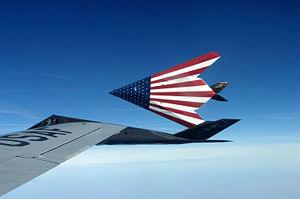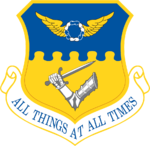121st Air Refueling Wing: Difference between revisions
→History: edited and expanded |
→Ohio Air National Guard: edited and expanded |
||
| Line 91: | Line 91: | ||
* [[166th Fighter Squadron]], Lockbourne Army Airfield |
* [[166th Fighter Squadron]], Lockbourne Army Airfield |
||
The squadrons was equipped with F-51D Mustangs with a mission of air defense of the State of Ohio. On 31 October 1950 the 121st Fighter Wing was established, and the 55th Fighter Wing was disbanded, its personnel and mission assumed by the new 121st Fighter Wing. The 121st Fighter Groups and its assigned squadrons were assigned to the new 121st FW. |
The squadrons was equipped with F-51D Mustangs with a mission of air defense of the State of Ohio. On 31 October 1950 the 121st Fighter Wing was established, and the 55th Fighter Wing was disbanded, its personnel and mission assumed by the new 121st Fighter Wing. The 121st Fighter Groups and its assigned squadrons were assigned to the new 121st FW. |
||
====Korean War Federalization==== |
|||
With the surprise invasion of South Korea on 25 June 1960, and the regular military's complete lack of readiness, most of the Air National Guard was federalized placed on active duty. |
|||
* The 162d Fighter Squadron was not federalized and remained at Cox-Dayton Municipal Airport and continued its air defense mission. |
|||
* The 164th Fighter Squadron was federalized on 10 February 1951. The 164th however was selected to remain at Mansfield Lahm Regional Airport and continue the air defense mission, being operationally gained by the [[Eastern Air Defense Force]], [[Air Defense Command]]. With the end of the federalization of the Air National Guard in 1952, the 164th again was assigned to the 121st Tactical Fighter Group at Columbus. |
|||
* The 166th Fighter Squadron was federalized on 10 February 1951 and assigned to the Federalized Indiana ANG [[122d Fighter-Interceptor Group]] with an [[Air Defense Command]] commitment. The squadron initially remained at Lockbourne and flew air defense training missions. On 20 September, the 166th was reassigned to the Federalized Oregon ANG [[142d Fighter-Interceptor Group]] which was headquartered at Chicago [[O'Hare International Airport]] with no change of mission. However, [[Strategic Air Command]] (SAC) had taken over Lockbourne AFB on 1 April 1951 it was decided to move the 166th FIS to [[Youngstown-Warren Air Reserve Station|Youngstown Municipal Airport]], Ohio, which was accomplished on 31 October 1952. The squadron was released from Federal Service and returned to Ohio State Control on 1 November, remaining in Youngstown. |
|||
===Lineage=== |
===Lineage=== |
||
Revision as of 05:53, 15 November 2012
| 121st Air Refueling Wing | |
|---|---|
 A pair of specially painted F-117 Nighthawks fly off from their last refueling by the Ohio National Guard's 121st Air Refueling Wing. | |
| Active | 1942-Present |
| Country | |
| Branch | |
| Type | Wing |
| Role | Air Refueling |
| Part of | Ohio Air National Guard |
| Garrison/HQ | Rickenbacker Air National Guard Base, Columbus, Ohio |
| Tail Code | "Ohio" Blue/Red Tail Stripe |
| Insignia | |
| 121st Air Refueling Wing emblem |  |
The 121st Air Refueling Wing (121 ARW) is a unit of the Ohio Air National Guard, stationed at Rickenbacker Air National Guard Base, Columbus, Ohio. If activated to federal service, the Wing is gained by the United States Air Force Air Mobility Command.
Overview
The 121st Air Refueling Wing's KC-135 Stratotanker mission is to provide the core aerial refueling capability for the U.S. Air Force and the Air National Guard. This unique aircraft enhances the Air Force's capability to accomplish its primary missions of Global Reach and Global Power. It also provides aerial refueling support to Air Force, Navy, Marine Corps, and allied nation aircraft. The KC-135 is capable of transporting litter and ambulatory patients using patient support pallets during aeromedical evacuations.
Units
The 121st Air Refueling Wing consists of the following units:
- 121st Operations Group
- 121st Maintenance Group
- 121st Mission Support Group
- 121st Medical Group
History
World War II
- See 357th Fighter Group for extended World War II history
Used P-39 Aircobras in preparing for duty overseas. Moved to England in November 1943 and became part of VIII Fighter Command. Trained with P-51 Mustangs and began combat operations on 11 February 1944 by making a fighter sweep over Rouen. Served primarily as a bomber escort organization, providing penetration (target) and withdrawal support for bombers that attacked strategic objectives on the Continent. Participated in the assault against the German Air Force and aircraft industry during Big Week, 20-25 February 1944.
Received a Distinguished Unit Citation for two escort missions in which heavy opposition was encountered from enemy fighters: on 6 March 1944 provided target and withdrawal support during the first attack that heavy bombers of Eighth Air Force made on Berlin; on 29 Jun 1944 protected bombers that struck targets at Leipzig. Received second DUC for operations on 14 January 1945 when the group, covering bombers on a raid to Derben, broke up an attack by a large force Of interceptors and in the ensuing aerial battle destroyed a number of the enemy planes. In addition to escort the group conducted counter-air patrols, made fighter sweeps, and flew strafing and dive-bombing missions in which it attacked airdromes, marshalling yards, locomotives, bridges, barges, tugboats, highways, vehicles, fuel dumps, and other targets. Participated in the invasion of Normandy in Jun 1944; the breakthrough at St Lo in July; the Battle of the Bulge, Dec 1944-Jan 1945; and the airborne assault across the Rhine in Mar 1945. Flew its last mission, an escort operation, on 25 April 1945.
Moved to Germany in Jul and assigned to United States Air Forces in Europe for duty with the army of occupation. Inactivated in Germany on 20 August 1946.
Ohio Air National Guard
The wartime 357th Fighter Group was re-designated as the 121st Fighter Group, and was allotted to the Ohio Air National Guard, on 24 May 1946. It was organized at Lockbourne Army Airfield, Columbus, Ohio, and was extended federal recognition on 20 June 1948 by the National Guard Bureau. The 121st Fighter Group was bestowed the lineage, history, honors, and colors of the 357th Fighter Group.
Assigned to the Ohio ANG 55th Fighter Wing, the 121st Fighter Group consisted of the following operational squadrons:
- 162d Fighter Squadron, Cox-Dayton Municipal Airport
- 164th Fighter Squadron, Mansfield Lahm Regional Airport
- 166th Fighter Squadron, Lockbourne Army Airfield
The squadrons was equipped with F-51D Mustangs with a mission of air defense of the State of Ohio. On 31 October 1950 the 121st Fighter Wing was established, and the 55th Fighter Wing was disbanded, its personnel and mission assumed by the new 121st Fighter Wing. The 121st Fighter Groups and its assigned squadrons were assigned to the new 121st FW.
Korean War Federalization
With the surprise invasion of South Korea on 25 June 1960, and the regular military's complete lack of readiness, most of the Air National Guard was federalized placed on active duty.
- The 162d Fighter Squadron was not federalized and remained at Cox-Dayton Municipal Airport and continued its air defense mission.
- The 164th Fighter Squadron was federalized on 10 February 1951. The 164th however was selected to remain at Mansfield Lahm Regional Airport and continue the air defense mission, being operationally gained by the Eastern Air Defense Force, Air Defense Command. With the end of the federalization of the Air National Guard in 1952, the 164th again was assigned to the 121st Tactical Fighter Group at Columbus.
- The 166th Fighter Squadron was federalized on 10 February 1951 and assigned to the Federalized Indiana ANG 122d Fighter-Interceptor Group with an Air Defense Command commitment. The squadron initially remained at Lockbourne and flew air defense training missions. On 20 September, the 166th was reassigned to the Federalized Oregon ANG 142d Fighter-Interceptor Group which was headquartered at Chicago O'Hare International Airport with no change of mission. However, Strategic Air Command (SAC) had taken over Lockbourne AFB on 1 April 1951 it was decided to move the 166th FIS to Youngstown Municipal Airport, Ohio, which was accomplished on 31 October 1952. The squadron was released from Federal Service and returned to Ohio State Control on 1 November, remaining in Youngstown.
Lineage
- Constituted as 357th Fighter Group on 1 December 1942 and activated the same day
- Inactivated in Germany on 20 August 1946
- Re-designated: 121st Fighter Group, and allotted to Ohio ANG, on 21 August 1946
- Extended federal recognition on 26 June 1948
- Established as 121st Fighter Wing, 1 November 1951
- Re-designated: 121st Fighter-Bomber Wing, 16 October 1952
- Re-designated: 121st Fighter-Interceptor Wing, 1 November 1952
- Re-designated: 121st Fighter-Bomber Wing, 1 November 1957
- Re-designated: 121st Tactical Fighter Wing, 1 September 1961
- Federalized and ordered to active service on: 1 October 1961
- Elements operated as: 7121st Tactical Wing, 4 November 1961-9 August 1962
- Released from active duty and returned to Ohio state control, 20 August 1952
- Re-designated: 121st Air Refueling Wing, 16 January 1993
Assignments
- IV Fighter Command, 1 December 1942
- 66th Fighter Wing, 31 January 1944-20 August 1946
- 55th Fighter Wing, 26 June 1948
- Ohio Air National Guard, 1 November 1951
- Gained by: Eastern Air Defense Force, Air Defense Command
- Gained by: Tactical Air Command, 1 November 1957
- Ninth Air Force, 1 October 1961
- Elements attached to: Seventeenth Air Force, United States Air Forces in Europe, 4 November 1961-9 August 1962
- Ohio Air National Guard, 10 August 1962
- Gained by: Tactical Air Command
- Gained by: Air Combat Command, 1 June 1992
- Gained by: Air Mobility Command, 16 January 1993-Present
Components
- 121st Fighter (later Fighter-Bomber, Fighter-Interceptor, Tactical Fighter) Group, 1 November 1951-30 June 1974
- 160th Air Refueling Group, 8 July 1961-1 October 1993
- 178th Tactical Fighter (later Fighter) Group, 15 October 1962-1 October 1995
- 179th Tactical Fighter (later Tactical Airlift, Airlift) Group, 15 October 1962-11 October 1995
- 180th Tactical Fighter (later Fighter) Group, 15 October 1962-11 October 1995
- 112th Fighter Squadron, 2 December 1946-2 December 1946; 10 July 1952-1 October 1961; 1 September-15 October 1962
- 145th Air Transport (later Aeromedical Airlift, Air Refueling) Squadron, 17 March 1956-8 July 1961; 1 October 1993-Present
- 362d Fighter Squadron (G4): 1 December 1942-20 August 1946
- Re-designated: 162d Fighter Squadron, 26 June 1948-15 October 1962
- 363d Fighter Squadron (B6): 1 December 1942-20 August 1946
- Re-designated: 164th Fighter Squadron, 26 June 1948-15 October 1962
- 364th Fighter Squadron (C5): 1 December 1942-20 August 1946
- Re-designated: 166th Fighter (later Fighter-Interceptor, Fighter-Bomber, Tactical Fighter, Fighter, Air Refueling) Squadron, 26 June 1948-26 January 1968; 18 June 1969-Present
Stations
|
|
Aircraft
|
|
References
![]() This article incorporates public domain material from the Air Force Historical Research Agency
This article incorporates public domain material from the Air Force Historical Research Agency


